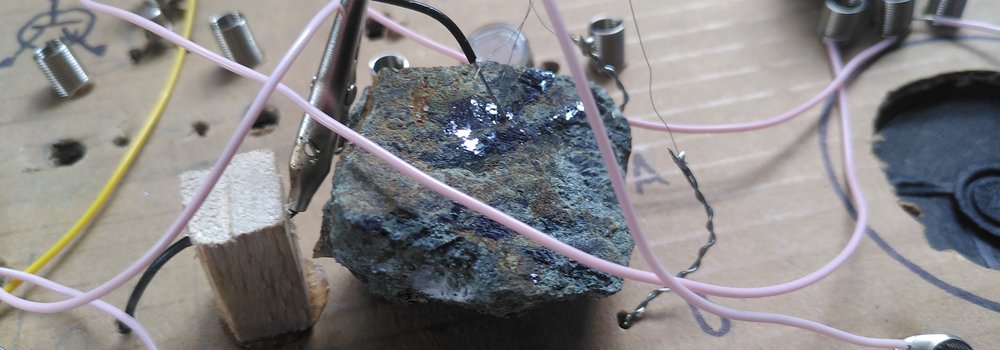A research phase was required for Organised Atoms before planning our field trip and workshop, as a lot of the technology we are using is obsolete, and the information difficult to find. We had some pointers and inspiration from projects like The Crystal World by Martin Howse and Jonathan Kemp, and tech archeology such as Crystalradio.net.
Our method has been to build a variety of analogue synthesiser circuits where naturally formed minerals are used alongside normal electronic components which contain material grown in lab conditions (although from material still extracted from mining) and are designed to provide consistent and predictable results. Of course, naturally formed crystals which solidified hundreds of millions of years ago are wonderfully chaotic and unpredictable in comparison. Finding where to put these crystals to make the most of this chaos has been a challenging process.
Semiconducting minerals and Cornish source sites
To start with we have a small range of crystals we've collected, all from the Gwennap area of Cornwall:
- Pyrite from Nangiles Mine
- Pyrite and Cuprite from Wheal Unity Wood
- Chalcopyrite from Wheal Virgin
- Wolframite from Poldice Mine
- Galena from Wheal Lovelace
All of these are semiconductors, and all apparently have quite different properties. Cuprite for example is currently at the forefront of solar power research. However, from our tests it seems that there is as much variation between specific source localities as there is between the types of mineral themselves, presumably down to different growth processes, temperatures and impurities. This is particularly intriguing as some of these mines are within a few hundred metres of each other - mined from lodes (rocks containing lots of minerals) that would have been part of the same geological formation. One of the the purposes of our Flamm workshop will be to test many more combinations of circuit/mineral/locality than this all together at the same time.
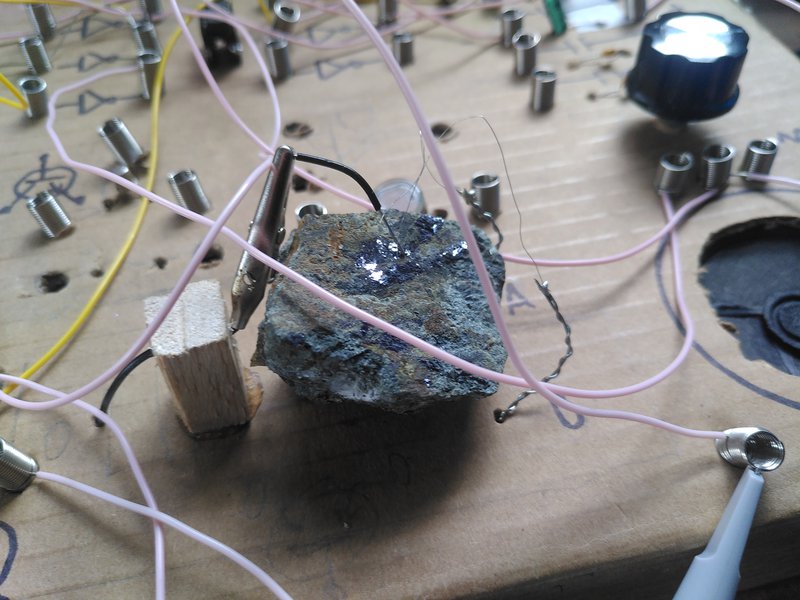
We set up our minerals in the same manner as the original old time crystal radio sets, with one (or two) terminals connected to a thin 'cat's whisker' that tickles the surface of the crystal to provide the semiconducting 'junction', and the other connected to the crystal itself more firmly to provide the normally conducting connection. We've found that rather than soldering them we can simply wrap smaller crystals in aluminum foil and use a crocodile clip to provide the connection which is a bit safer, and makes it easy to swap and change crystals. In the case where the crystal is still attached to the host rock and it's too fragile to remove (often in the case of galena or cuprite) we can use a thicker wire with more pressure to provide the normal connection alongside the thinner semiconducting cat's whiskers.
The usual way to demonstrate and test semiconducting properties is to use a curve tracer. This is a way to test a material by using an oscilloscope to plot a varying voltage applied across a material against the current it allows to pass through. Something non-conducting would be a flat horizontal line (no current passes, whatever the voltage is) while something conducting normally will show a completely straight line - where the angle depends on the resistance of the material.
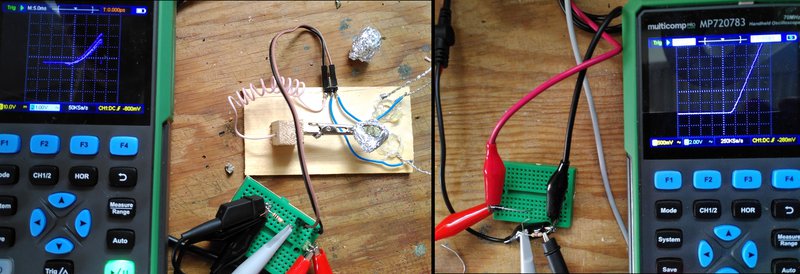
Above we can see a comparison curves between pyrite on the left and a standard silicon diode on the right. The pyrite is noisy and not nearly as clean as the packaged diode, but we can see a similarity between the curves they produce. They are both flat on the left (negative) side of the graph (non conducting) and rising on the right (conducting).
Here are some comparisons for different minerals collected from mine waste at various localities - we get very variable and interesting curves:
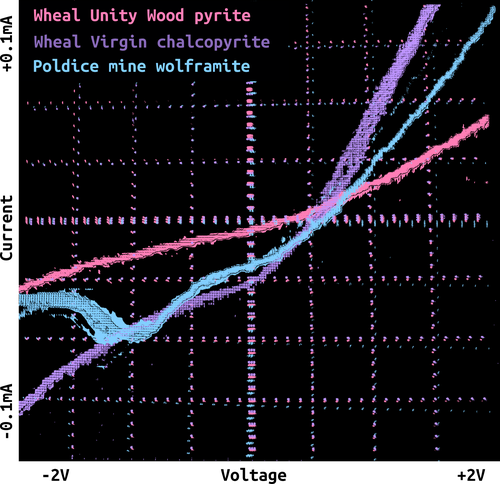
As a side note, the wolframite above seems to have an area of 'negative resistance' on the left side, where current reduces as negative voltage increases - this could be a kind of tunnel diode effect. Something to look more into at some point.
Circuit design
So we can play with a curve tracer to see what happens at specific 'junctions' on a crystal surface at a specific point in time, but there is a lot more complexity than can be captured in these graphs. This is one of those situations where listening is a more appropriate medium for understanding.
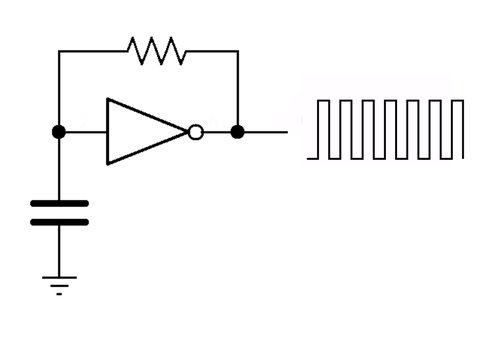
Oscillators are the starting point for synthesisers as they provide the starting sound wave, and the simplest oscillators it's possible to build are a single inverting 'NOT gate', a resistor and a capacitor. They are cheap - with a chip like the CD40106 you can build six of these oscillators all running at different frequencies. It's particularly satisfying because it's a chip used for digital circuits that we deliberately misuse by wiring it back into itself to exploit it's analogue properties, as it provides a square wave output.
These oscillators are not very reliable, and they tend to interfere with each other - but that all fits all the better with our purposes. They are also easy to combine together to provide more complex waveforms, for example we can add a single transistor to allow one oscillator to modulate the frequency of the next.
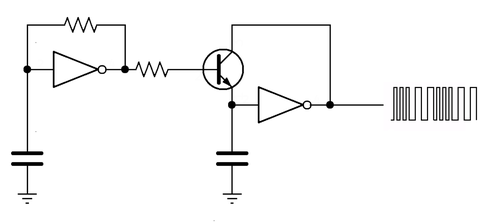
The original transistors were very similar to the diodes we've been building - they just added a second 'cat's whisker'. The theory is that the voltage sent into the crystal changes how much current can pass from one cat's whisker to the other, creating the 'electronic switch' that reduced the energy and space needed to build computers. This is what we are trying in the top photo in this post, we have two cat's whiskers tickling the galena crystal in a circuit. We could embark on more analysis with the oscilloscope, but we are now in the world of sound - so we can test it by listening instead - we can very quickly get strange and interesting results.
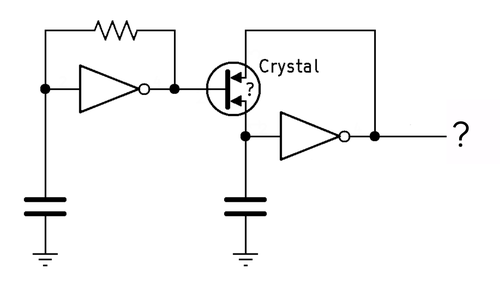
It's likely that there are many many things going on in these circuits at the same time - electronically, probably some capacitance across the junctions, as well as varying resistance when the cat's whiskers aren't actually providing semiconducting junctions, and lots of other side effects. Physically we are mounting the speakers to the same box as the crystals, so there will also be a form of extremely odd feedback as the audio moves the cat's whiskers slightly in time with the sounds they are producing.
However, it is possible to hear a few things that seem indicative of semiconducting - the bursts of noise and unpredictability coming from electrons spilling across junctions when they reach a voltage threshold and then being cut off suddenly when they drop slightly back down. Sometimes they create sounds almost exactly like the transistor in this circuit, but often not. Leaving them running for long periods of time, they seem to gradually switch between different states - never quite settling down. It's likely that temperature changes affect them - and potentially light changes too.
In our workshop we will be building simple circuits like above and try to explore some of these effects together, using our ears to understand our fossicked crystals alongside the more usual methods of hardness, streak colour and lustre. As the participants will be taking their circuits and crystals home, we'll also be providing details of more advanced circuits to try out in their own time, for example introducing low and highpass filtering, expression via light sensors or using LFO oscillators to provide rhythmic musical structures.

